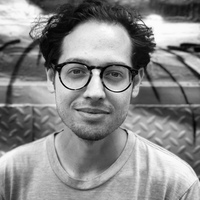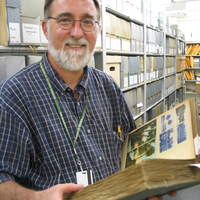
Anthony M . Huffman
Independent scholar, curator, cultural critic, and adjunct lecturer based in Brooklyn, NY. I've held administrative, curatorial, research, and teaching posts with private collectors, cultural nonprofits, government agencies, artist studios, alternative project spaces, commercial galleries, museums, and institutions of higher education. These varied settings have provided a wide range of vantage points from which to engage with modern and contemporary art, theory, and practice—and have fundamentally shaped my research interests.
As such, the primary themes I am most keen to interrogate include: the social history of art; links between the history of the decorative, murals, ornamentation, and abstraction; revisionist histories of modern European art; craft traditions in contemporary art; debates about the boundary and relationship between media; objecthood, context, and the circulation of meaning; public art, architecture, and spatial politics; semiotics; art theory and historiography; sensory studies and hierarchy of the senses; and critical theory. To varying degrees, I have probed these topics in relation to diverse works in discursive formats, such as exhibitions, catalogue texts, public programs, reviews, and critical essays. My research has been presented at interdisciplinary academic conferences across the United States, and been supported through grants and residencies from the Knight Foundation, the Baker-Nord Center for the Humanities, Phi Beta Kappa, and Lower Manhattan Cultural Council.
In my independent curatorial practice, I strive to mount exhibitions that are conceptually rigorous, thoughtfully organized, accessible to a wide audience, and most importantly contribute to expansionist forms of art history by showcasing the work of artists from historically marginalized communities. I’m also interested in working closely with contemporary practitioners on site-specific artworks that meaningfully engage with place, history, and community. Last, I aspire to explore food as a cultural product and vehicle for preserving the heritage of communities in collaboration with artists and chefs.
Supervisors: Dr. Andrea Wolk Rager, Prof. José Carlos Teixeira, and Dr. James J. Bloom
As such, the primary themes I am most keen to interrogate include: the social history of art; links between the history of the decorative, murals, ornamentation, and abstraction; revisionist histories of modern European art; craft traditions in contemporary art; debates about the boundary and relationship between media; objecthood, context, and the circulation of meaning; public art, architecture, and spatial politics; semiotics; art theory and historiography; sensory studies and hierarchy of the senses; and critical theory. To varying degrees, I have probed these topics in relation to diverse works in discursive formats, such as exhibitions, catalogue texts, public programs, reviews, and critical essays. My research has been presented at interdisciplinary academic conferences across the United States, and been supported through grants and residencies from the Knight Foundation, the Baker-Nord Center for the Humanities, Phi Beta Kappa, and Lower Manhattan Cultural Council.
In my independent curatorial practice, I strive to mount exhibitions that are conceptually rigorous, thoughtfully organized, accessible to a wide audience, and most importantly contribute to expansionist forms of art history by showcasing the work of artists from historically marginalized communities. I’m also interested in working closely with contemporary practitioners on site-specific artworks that meaningfully engage with place, history, and community. Last, I aspire to explore food as a cultural product and vehicle for preserving the heritage of communities in collaboration with artists and chefs.
Supervisors: Dr. Andrea Wolk Rager, Prof. José Carlos Teixeira, and Dr. James J. Bloom
less
Related Authors
Alessandro Grelli
Università degli Studi di Padova
Earle Spamer
American Philosophical Society
Noam Gonnen
Ben Gurion University of the Negev
Lydia Matthews
The New School University
Richard W Ellis
University of Wisconsin-Madison
Jeffrey Richmond-Moll
Peabody Essex Museum
Loredana Pazzini - Paracciani
SOAS University of London
InterestsView All (12)










Uploads
Undergraduate Projects by Anthony M . Huffman
question of whether nuclear weapons are legal under international law. The research material
used for this investigation consists of customary international law, including state behavior and United Nations General Assembly Resolutions; an advisory opinion of the International Court of Justice; and the principles and conventions of international humanitarian law. Ultimately, after a thorough inspection of the sources of international law, it will be shown that due to their virulent nature atomic weapons are a blatant violation of the rules and norms of war.
Graduate Projects by Anthony M . Huffman
Contemporary Arts Criticism by Anthony M . Huffman
question of whether nuclear weapons are legal under international law. The research material
used for this investigation consists of customary international law, including state behavior and United Nations General Assembly Resolutions; an advisory opinion of the International Court of Justice; and the principles and conventions of international humanitarian law. Ultimately, after a thorough inspection of the sources of international law, it will be shown that due to their virulent nature atomic weapons are a blatant violation of the rules and norms of war.
installation explicitly draws upon the format and appeal of commercial escape rooms while implicitly being informed by philosophical thought experiments, such as Rawls’s, that have probed concepts of identity, justice, privilege, and power. Puno adeptly plays with the metaphoric potential of gaming elements, language, and conditions to create an introspective experience that facilitates self-examination of privilege.
Reisman has judiciously brought together a formidable cadre of artists, including El Anatsui, Maren Hassinger, Elana Herzog, Samuel Levi Jones, Mary Mattingly, Lina Puerta, Michael Rakowitz, Jean Shin, Shinique Smith, Mierle Laderman Ukeles, Roberto Visani, and Michael Kelly Williams. These twelve artists of varying art historical moments, media, and motivations are part of an intellectual journey about material usage, objecthood, and artistic intervention/re-purposing in the life of discarded items. Concurrently, the objects and installations in one way or another comment on the visible and invisible systems that operate in our daily lives. The myriad assemblages pulsate a Foucaultian energy and speak to social ills/systems in desperate need of repair, such as waste collection and management; gun regulation; urban planning; emergency response efforts; the fashion industry; museum acquisition policies and cultural patrimony; and the military-industrial complex. The show does much more than raise questions about these systems though; it offers potential remedies to some of the most deleterious socio-political ails of our time. As Reisman explains in the catalogue essay, each “artist offers a methodology that speaks to a crisis, from the personal and intimate to the global and collectively consequent.” I have divided my analysis and assessment of the exhibition into two broad categories, attempting to elaborate on the major themes and issues as one would encounter them while progressing through the gallery space. In the first section, I consider works and themes dealing with the history of civilizations; cultural heritage; gun violence; natural disasters; the circulation of power; natural resources and the U.S. military; and the American judicial system. The latter half is concerned with the fashion industry; the geo-politics of the developing and developed worlds; nature, architecture, and culture; and shared public places and urban social theory.
What’s most provocative about Dress Up, Speak Up is that many of the core motifs that unite the objects on display--forms of protest through attire, identity performance, questioning meta-narratives, remembering the oppression and exploitation of minorities--gain increased potency and relevance due to the exhibition’s site-specificity. 21c Museum Hotel now occupies the former fifteen-story First National Bank and Trust Company building, built in 1913, which is less than one hundred feet from the block known as Cheapside Park. The storied block has been the topic of much debate over the past year because it continues to house two commemorative statues of Confederate generals, and most significantly was a slave auction block where thousands of African Americans were sold during the nineteenth century. This site-specific tension calls upon visitors to the city and its own residents to come to terms with how art, architecture, and public spaces have an impact on past and present, and sets the bar for future exhibition programming to be equally provocative and relevant.